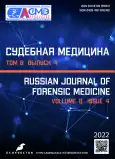Characteristics of injuries in cyclists injured when other vehicles collide with the side of the body of moving bicycles
- Authors: Indiaminov S.I.1, Abdumuminov K.N.2, Boymanov F.K.1
-
Affiliations:
- Samarkand State Medical Institute
- Republican Scientific and Practical Center of Forensic Medical Examination, Samarkand branch
- Issue: Vol 8, No 4 (2022)
- Pages: 57-65
- Section: Original study articles
- URL: https://journals.rcsi.science/2411-8729/article/view/122471
- DOI: https://doi.org/10.17816/fm725
- ID: 122471
Cite item
Full Text
Abstract
BACKGROUND: Bicycle injuries, as a separate type of traffic accidents, require forensic medical examinations to establish the mechanism, duration, and severity of injuries. Forensic medical aspects of cycling injuries are insufficiently covered in the literature.
AIM: To study the nature and features of the injury formation in cyclists who sustained injured when other vehicles hit the side of the moving bicycle.
MATERIALS AND METHODS: The results of forensic medical examinations of 51 cyclists who died when the moving bicycles collided with the side of vehicles.
RESULTS: The most frequently observed injuries in cyclists are traumatic brain injury (21.56%) and combined injuries, namely, head and chest (15.68%), lower extremities with trauma to the head, and chest (11.76%). Nearly all deceased cyclists sustained damage to the head (96.0%), which was characterized by the formation of a severe contusion of the brain with fractures of the parietotemporal and occipital bones. Damage to the chest and chest cavity organ was also observed frequently (50.69%). Rib fractures were noted in 74.2% of cases. Injuries to the abdominal organs were detected in 20.15% of the cases, such as liver rupture and hemorrhage in the ligaments of organs. Diaphyseal comminuted fractures of the bones of the lower leg and femur were also observed.
CONCLUSION: The most common types of injuries in deceased cyclists in a side collision of other vehicles with a moving bicycle are traumatic brain injury and combined injuries of the head, chest, and fractures of the bones of the lower extremities in combination with a head and chest injury. Damage to the head was characterized by the formation of linear, depressed, and comminuted fractures of the parietal–temporal and occipital bones. Damage to the chest was characterized by fractures of the upper ribs and bruises of the lungs. Damage to the skin, resembling a picture of a “road rash,” was noted on the anterolateral body parts.
Keywords
Full Text
##article.viewOnOriginalSite##About the authors
Sayit I. Indiaminov
Samarkand State Medical Institute
Author for correspondence.
Email: sud-medsav@mail.ru
ORCID iD: 0000-0001-9735-0338
MD, Dr. Sci. (Med.), Professor
Uzbekistan, 18, Amir Temur str., Samarqand, 140100Khasan N. Abdumuminov
Republican Scientific and Practical Center of Forensic Medical Examination, Samarkand branch
Email: sud-medsav@mail.ru
ORCID iD: 0000-0001-7686-1606
MD
Uzbekistan, SamarqandFarxod Kh. Boymanov
Samarkand State Medical Institute
Email: boymanovf@mail.ru
ORCID iD: 0000-0002-9584-5182
Associate Professor
Uzbekistan, 18, Amir Temur str., Samarqand, 140100References
- Forstatt ML. A dangerous trend. Children’s road traffic injuries: yesterday and today [electronic edition]. In: Fundamentals of life security. 2006;(3):38–42. (In Russ). Available from: http://libnn.ru/component/option,com_marc/task,view/id,30506/Itemid,88/. Accessed: 17.04.2022.
- Abdelrahman H, El-Menyar A, Sathianb B, et al. Bicycle-related traumatic injury hospitalizations: six years descriptive analysis in Qatar. J Inj Violence Res. 2019;11(2):233–242. doi: 10.5249/ jivr.v11i2.1162
- Beckwith K, James V, Kalaiselvan K, Ganapathy S. Bicycle injuries among the pediatric population at an emergency department in Singapore. Med J. 2019;60(7):343–346. doi: 10.11622/smedj.2019009
- Shilov SG, Semenyako MY. Features of cycling injury. In: Actual problems of modern medicine and pharmacy: Collection of reports of the XXIII International Scientific and Practical Conference of Students and Young Scientists, April 15–17. Minsk; 2019. P. 1373. (In Russ).
- Shah S, Sinclair SA, Smith GA, Xiang H. Pediatric hospitalizations for bicycle-related injuries. Inj Prev. 2007;13(5):316–321. doi: 10.1136/ip.2007.016048
- Artyushkevich VS. Mechanogenesis of motorcycle injury. In: Modern methods of diagnosis and treatment of patients with injuries and diseases of the musculoskeletal system: Materials of the scientific and practical conference of traumatologists-orthopedists of the Republic of Belarus. Minsk; 2006. Р. 30–33. (In Russ).
- Alshevsky VV, Arutyunov SD, Beleshnikov IL, et al. Forensic medicine and forensic medical expertise: National guidelines. Ed. by Y.I. Pigolkin. Moscow: GEOTAR-Media; 2014. 728 p. (In Russ).
- Puranik S, Long J, Coffman S. Profile of pediatric bicycle injuries. South Med J. 1998;91(11):1033–1037. doi: 10.1097/00007611-199811000-00008
- Li G, Baker SP, Fowler C, DiScala C. Factors related to the presence of head injury in bicycle-related pediatric trauma patients. J Trauma. 1995;38(6):871–875. doi: 10.1097/00005373-199506000-00007
- Nakayama DK, Pasieka KB, Gardner MJ. How bicycle-related injuries change bicycling practices in children. Am J Dis Child. 1990;144(8):928–929. doi: 10.1001/archpedi.1990.02150320092035
Supplementary files







